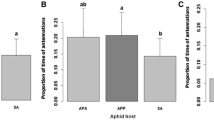Summary
Pea aphids show intraclonal variability in antipredator behaviour. Among the offspring of a single parthenogenetically reproducing female, some individuals drop from the plant in response to alarm pheromone while others remain on the plant. We demonstrate that this intraclonal behavioural variability can be altered by selection. The proportion of aphids dropping in response to alarm pheromone was significantly greater in lines in which this behaviour was selected than in clonally identical lines in which the opposite phenotype was favoured. This change occurred within one generation and could not be attributed to grand-maternal effects, nor to environmental effects. These results demonstrate the ability of clonal aphids to adapt to changes in the environment within a single generation.
Similar content being viewed by others
References
Beranek, A.P. (1974) Esterase variation and organophosphate resistance in populations ofAphis fabae andMyzus persicae.Entomol. Exp. Appl. 17, 129–42.
Blackman, R.L. (1971) Variation in photoperiodic response within natural populations ofMyzus persicae.Bull. Entomol. Res. 60, 533–46.
Blackman, R.L. (1979) Stability and variation in aphid clonal lineages.Biol. J. Linn. Soc. 11, 259–77.
Brodsky, L.M. and Barlow, C.A. (1986) Escape responses of the pea aphid,Acyrthosiphon pisum (Harris) (Homoptera: Aphididae): influence of predator type and temperature.Can J. Zool. 64, 937–9.
Brough, C.N., Dixon, A.F.G. and Kindlmann, P. (1990) Pattern of growth and fat content of somatic and gonadal tissues of virginoparae of the vetch aphid,Megoura viciae.Entomol. Exp. Appl. 56, 269–75.
Bunting, S. and van Emden, H.S. (1980) Rapid response to selection for increased enzyme activity on small populations of an apomictic clone ofMyzus persicae.Nature 285, 502–3.
Clegg, J.M. and Barlow, C.A. (1982) Escape behaviour of the pea aphidAcyrthosiphon pisum (Harris) in response to alarm pheromone and vibration.Can J. Zool. 60, 2245–52.
Cognetti, G. (1961) Endomeiosis in parthenogenetic lines of aphids.Experientia. 17, 168–9.
Crowley, P.H. (1992) Resampling methods for computation-intensive data analysis in ecology and evolution.Ann. Rev. Ecol. Syst. 23, 405–47.
Devonshire, A.L. and Sawicki, R.M. (1979) Insecticide-resistantMyzus persicae as an example of evolution by gene duplication.Nature 280, 140–1.
Dill, L.M., Fraser, A.F.G. and Roitberg, B.D. (1990) The economics of escape behaviour in the pea aphid,Acyrthosiphon pisum.Oecologia 83, 473–8.
Dixon, A.F.G. (1985)Aphid Ecology. Blackie and Son, London.
Dunn, J.A. and Kempton, D.P. (1966) Non-stable resistance to demeton-methyl in a strain ofMyzus persicae.Entomol Exp. Appl. 9, 67–73.
Field, L.M., Devonshire, A.L. and Forde, B.G. (1988) Molecular evidence that insecticide resistance in peach-potato aphids (Myzus persicae. Sulz.) results from amplification of an esterase gene.Biochem. J. 251, 309–12.
Hardie, J. (1987) The photoperiodic control of wing development in the black bean aphid,Aphis fabae.J. Insect Physiol. 33, 543–9.
Kislow, C.J. and Edwards, L.J. (1972) Repellent odour in aphids.Nature 235, 108–9.
Krepp, S.R. (1977) Genotypic and phenotypic variation in populations ofDaphnia pulex. MSc Thesis. Dept. of Zoology, University of British Columbia.
Leather, S.R., Wellings, P.W. and Walters, K.F.A. (1988) Variation in ovariole number within the Aphidoidea.J. Nat. History 22, 381–93.
Lees, A.D. (1967) The production of the apterous and alate forms in the aphidMegoura viciae Buckton, with special reference to the role of crowding.J. Insect Physiol. 13, 289–318.
Lynch, M. and Gabriel, W. (1983) Phenotypic evolution and parthenogenesis.Am. Nat. 122, 745–64.
Maynard Smith, J. (1978).The Evolution of Sex. Cambridge University Press, London.
Mousseau, T.A. and Dingle, H. (1991) Maternal effects in insect life histories.Ann. Rev. Entomol. 36, 511–34.
Nault, L.R., Edwards, L.J. and Styer, W.E. (1973) Aphid alarm pheromones: secretion and reception.Environ. Entomol. 2, 101–5.
Noreen, E.W. (1989)Computer-intensive Methods for Testing Hypotheses: An Introduction. John Wiley & Sons. Toronto.
Rice, W.R. (1989) Analyzing tables of statistical tests.Evolution 43, 223–5.
Roitberg, B.D. and Myers, J.H. (1978) Adaptation of alarm pheromone responses of the pea aphidAcyrthosiphon pisum (Harris).Can J. Zool. 56, 103–8.
Roitberg, B.D. and Myers, J.H. (1979) Behavioural and physiological adaptations of pea aphids (Homoptera: Aphididae) to high ground temperatures and predator disturbance.Can. Entomol. 111, 515–19.
Shull, A.F. (1932) Clonal differences and clonal changes in the aphidMacrosiphum solanifolli.Am. Nat. 66, 385–419.
Soumalainen, E., Saura, A. and Lokki, J. (1976) Evolution of parthenogenetic insects. InEvolutionary biology (M. Hecht, W.C. Steere and B. Wallace, eds), vol. IX, pp. 209–57. Plenum Press, New York.
Stadler, B., Weisser, W.W. and Houston, A.I. (1994) Defence reactions in aphids: the influence of state and future reproductive success.J. Anim. Ecol. 63, 419–30.
Walters, K.F.A. and Dixon, A.F.G. (1983) Migratory urge and reproductive investment in aphids: variation within clones.Oecologia 58, 70–5.
Walters, K.F.A., Brough, C. and Dixon, A.F.G. (1988) Habitat quality and reproductive investment in aphids.Ecol. Entomol. 13, 337–45.
Ward, S.A., Wellings, P.W. and Dixon, A.F.G. (1983) The effect of reproductive investment on pre-reproductive mortality in aphids.J. Anim. Ecol. 52, 305–13.
Wellings, P.W., Leather, S.R. and Dixon, A.F.G. (1980) Seasonal variation in reproductive potential: a programmed feature of aphid life cycles.J. Anim. Ecol. 49, 975–85.
White, M.J.D. (1973)Animal Cytology and Evolution, 3rd edn. Cambridge University Press, Cambridge, UK.
Wilhoit, L.R. and Mittler, T.E. (1991) Biotypes and clonal variation in Greenbug (Homoptera: Aphididae) populations from a locality in California.Environ. Entomol. 20, 757–67.
Zar, J.H. (1984)Biostatistical Analysis. Prentice-Hall, Englewood Cliffs, NJ.
Author information
Authors and Affiliations
Rights and permissions
About this article
Cite this article
Andrade, M.C.B., Roitberg, B.D. Rapid response to intraclonal selection in the pea aphid (Acyrthosiphon pisum). Evol Ecol 9, 397–410 (1995). https://doi.org/10.1007/BF01237762
Issue Date:
DOI: https://doi.org/10.1007/BF01237762




